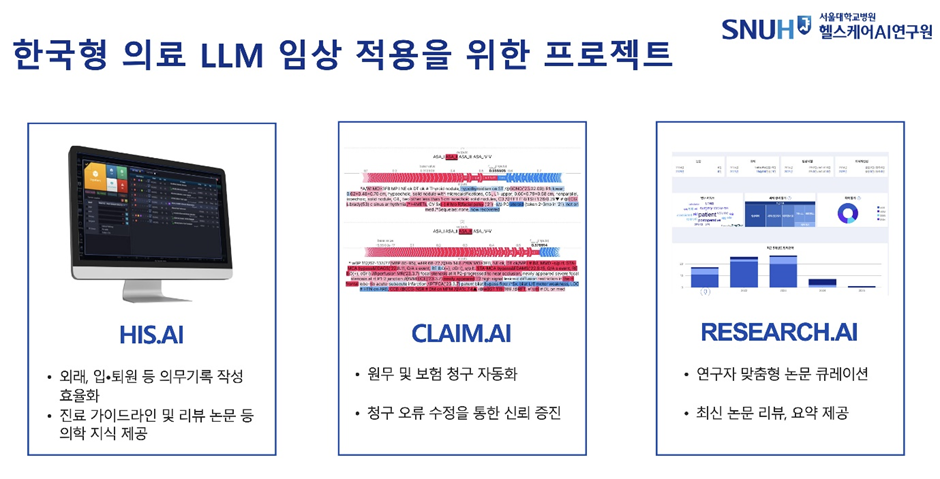Seoul National University Hospital develops Korea's first "Korean-style Medical Large Language Model (LLM)."
- Achieved an accuracy of 86.2%, surpassing the average accuracy of practicing physicians for the first time among open-source models.
- Utilized large-scale medical data, including electronic medical records, Picture Archiving and Communication System (PACS), digital pathology systems, and genomic data.
- Developed as an AI model specialized for the Korean healthcare system, enhancing clinical efficiency and strengthening patient safety.
Projects for the Clinical Application of the Korean-style Medical LLM
 [Image] Projects for Clinical Application of the Korean-style Medical LLM: HIS.AI (Streamlining Medical Record Creation), CLAIM.AI (Automation of Billing and Insurance Claims), RESEARCH.AI (Customized Research Paper Curation for Researchers).
[Image] Projects for Clinical Application of the Korean-style Medical LLM: HIS.AI (Streamlining Medical Record Creation), CLAIM.AI (Automation of Billing and Insurance Claims), RESEARCH.AI (Customized Research Paper Curation for Researchers).
Seoul National University Hospital (SNUH) recently announced the development of Korea's first "Korean-style medical large language model (LLM)." This model was developed using large-scale medical data such as the hospital's electronic medical records (EMR), Picture Archiving and Communication System (PACS), digital pathology system, and genomic data. It is designed to process medical information specific to Korea’s healthcare system, improve clinical efficiency, and enhance patient safety, marking a significant technological advancement. Through this model, SNUH plans to lead in competitive healthcare technologies globally and provide better medical services to patients.
Research and development on large language models (LLMs) is active worldwide, with specialized models like OpenAI's ChatGPT, Google's PaLM-MED2, and Microsoft's Med-LLaVA emerging in the medical field. However, existing medical LLMs are mainly optimized for Western medical knowledge, and they cannot fully comprehend Korean medical texts or local laws and clinical guidelines. SNUH recognized the need for an LLM that meets the demands of Korean medical professionals who use a mix of Korean and English and understand specialized medical knowledge, abbreviations, and linguistic characteristics.
To address this, SNUH began developing the Korean-style medical LLM in March 2024, based on Korean medical knowledge. They built a "Korean medical text corpus" using 38 million clinical texts, including inpatient, outpatient, surgery, prescription, and nursing records. After anonymizing and de-identifying the data, it was made available for secure internal use. This corpus played a crucial role in training the model to develop capabilities tailored to the Korean healthcare system.
Starting in 2025, SNUH plans to further enhance the model by integrating Korean medical laws, Korean-language research abstracts, clinical guidelines, medical term abbreviations, and standardization efforts. They will also create specialized training datasets based on actual clinical processes, develop a knowledge graph-based search-augmented generation (RAG) system, and build a multi-agent framework for multidisciplinary collaboration. These steps led to the completion of the Korean-style medical LLM in just one year. After verifying the model's performance and safety, it will be used in research and administrative support within the hospital.
The model achieved a remarkable 86.2% accuracy when tested on the past three years of the Korean Medical Licensing Examination (KMLE) data, surpassing the average accuracy of practicing physicians (79.7%). This demonstrates that the Korean-style medical LLM is a practical and viable technology in the healthcare field. Additionally, with its ability to process around 50,000 words at once, the model has excellent translation capabilities and is expected to expand its performance across various medical fields, improving the accuracy and efficiency of medical data processing.
SNUH plans to further enhance the LLM’s capabilities for practical use in clinical settings. The hospital intends to expand the model into a multimodal AI that integrates medical images and biometric signals. Projects such as "HIS.AI" for automating outpatient and inpatient discharge summaries, "CLAIM.AI" for streamlining billing and insurance claims, and "RESEARCH.AI" for personalized research paper curation are being developed. These projects are expected to reduce burnout among healthcare workers and significantly improve efficiency. As a result, medical professionals will be able to spend more time interacting directly with patients and providing care, thus creating a more patient-centered healthcare environment.
Professor Lee Hyung-chul (Deputy Director of the Healthcare AI Research Institute), who led the development of the LLM, said, "The Korean-style medical large language model was developed based on the medical knowledge of Seoul National University's excellent medical staff and represents a significant technological advancement in improving clinical efficiency and patient satisfaction." He added, "LLM technology will become an essential tool to assist doctors, ultimately improving the quality of healthcare services."
Hospital President Kim Young-tae stated, "Through the development of this Korean-style medical LLM, we have opened a new chapter in medical innovation by maximizing the efficiency of healthcare professionals and providing faster, more accurate medical services to patients. We will continue to adopt the latest technologies to provide the best possible healthcare services to our patients."